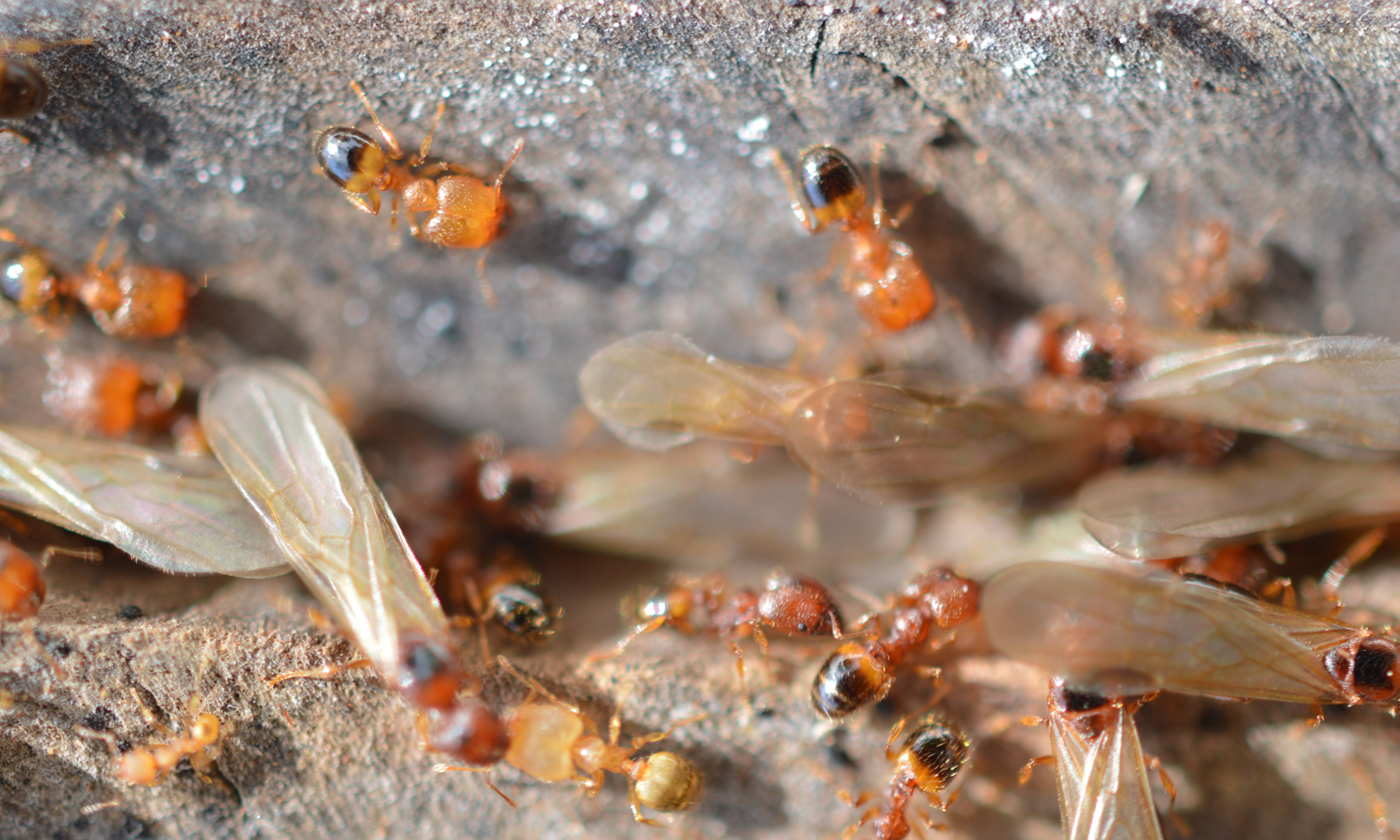Genome assembly of the temporary socially parasitic spiny ant Polyrhachis lamellidens and its host Camponotus japonicus
Iwai H, Kurihara Y, Kono N, Hojo MK, Yamaguchi K, Shigenobu S, Ozaki M, Koto A, Arakawa K (2025)
DNA Research 32 (2): dsaf005
Context‐dependent expression of variation in defensive behaviour in the lower termite Zootermopsis nevadensis.
Koyama Y, Yaguchi H, Maekawa K, Hojo MK (2023)
Ethology 129 (11): 585-591
Gene expression profiles of chemosensory genes of termite soldier and worker antennae.
Suzuki RH, Hanada T, Hayashi Y, Shigenobu S, Maekawa K, Hojo MK (2023).
Insect Molecular Biology 32(4): 424-435
Evolution of chemical interactions between ants and their mutualist partners.
Hojo MK (2022)
Current Opinion in Insect Science 52, 100943
Individual experience influences reconstruction of division of labour under colony disturbance in a queenless ant species.
Tanaka Y, Hojo MK, Shimoji H (2022)
Frontiers in Zoology 19 (1): 20.
Understanding of superorganisms: collective behavior, differentiation and social organization.
Miura T, Oguchi K, Yamaguchi H, Nakamura M, Sato D, Kobayashi K, Kutsukake N, Miura K, Hayashi Y, Hojo MK, Maekawa K, Shigenobu S, Kano T, Ishiguro, A (2022).
Artificial Life and Robotics, 27(2), 204-212.
Genomic and transcriptomic analyses of the subterranean termite Reticulitermes speratus: Gene duplication facilitates social evolution.
Shigenobu S, Hayashi Y, Watanabe D, Tokuda G, Hojo MY, Toga K, Saiki R, Yaguchi H, Masuoka Y, Suzuki R, Suzuki S, Kimura M, Matsunami M, Sugime Y, Oguchi K, Niimi T, Gotoh H, Hojo MK, Miyazaki S, Toyoda A, Miura T, Maekawa K (2022)
Proceedings of the National Academy of Sciences USA 119 (3) e2110361119.
Worker-dependent gut symbiosis in an ant.
Shimoji H, Itoh H, Matsuura Y, Yamashita R, Hori T, Hojo MK, Kikuchi Y (2021)
ISME Communications 1 (1) 60
Odor of achlorophyllous plants’ seeds drives seed‐dispersing ants.
Yamada M, Hojo MK, Imamura A (2021)
Ecology and Evolution 11(14): 9308-9317
Worker propensity affects flexible task reversion in an ant.
Shimoji H, Kasutani N, Ogawa S, Hojo MK (2020)
Behavioral Ecology and Sociobiology 74: 92
社会学習による行動伝播の生態学における役割
持田 浩治, 香田 啓貴, 北條 賢, 高橋 宏司, 須山 巨基, 伊澤 栄一, 井原 泰雄 (2020)
日本生態学会誌 70(3): 177-195
Characterization of localization, ligand binding, and pH-dependent conformational changes of two chemosensory proteins expressed in the antennae of the Japanese carpenter ant, Camponotus japonicus.
Wen D, Li X, Geng X, Hirai M, Ajito S, Takahashi K, Ozaki M, Hojo MK, Uebi T, Iwasa T (2020)
Zoological Science 37(4): 1-11
Markerless visual servo control of a servosphere for behavior observation of a variety of wandering animals.
Iwatani Y, Ogawa H, Shidara H, Sakura M, Sato T, Hojo MK, Honma A, Tsurui-Sato K (2019)
Advanced Robotics 33(3-4): 183-194
Putative Neural Network Within an Olfactory Sensory Unit for Nestmate and Non-nestmate Discrimination in the Japanese Carpenter Ant: The Ultra-structures and Mathematical Simulation.
Takeichi Y, Uebi T, Miyazaki N, Murata K, Yasuyama K, Inoue K, Suzaki T, Kubo H, Kajimura N, Takano J, Omori T, Yoshimura R, Endo Y, Hojo MK, Takaya E, Kurihara S, Tatsuta K, Ozaki K, Ozaki M (2018)
Frontiers in Cellular Neuroscience 12:310
Social transmission of information about a mutualist via trophallaxis in ant colonies.
Hayashi M, Hojo MK, Nomura M, Tsuji K (2017)
Proceedings of the Royal Society B 284(1861) 20171367
Regulation of neotenic differentiation through direct physical contact in the damp-wood termite Hodotermopsis sjostedti.
Shimoji H, Oguchi K, Hayashi Y, Hojo MK, Miura T (2017)
Insectes Sociaux 64(3): 393–401
Suppressive effects of dRYamides on feeding behavior of the blowfly, Phormia regina.
Maeda T¶, Nakamura Y¶, Shiotani H, Hojo MK, Yoshii T, Ida T, Sato T, Yoshida M, Miyazato M, Kojima M, Ozaki M* (2015)
Zoological Letters 1: 35
Antennal RNA-sequencing analysis reveals evolutionary aspects of chemosensory proteins in the carpenter ant Camponotus japonicus.
Hojo MK¶, Ishii K¶, Sakura M, Yamaguchi K, Shigenobu S, Ozaki M (2015)
Scientific Reports 5: 13541
Lycaenid caterpillar secretions manipulates attendant ant behavior.
Hojo MK, Pierce NE, Tsuji K (2015)
Current Biology 25(17): 2260-2264
Neuronal projections and putative interaction of multimodal inputs in the subesophageal ganglion in the blowfly, Phormia regina.
Maeda T*, Tamotsu S, Iwasaki M, Nisimura T, Shimohigashi M, Hojo MK, Ozaki M. (2014)
Chemical Senses 39(5): 391-401
Ants use partner specific odors to learn to recognize a mutualistic partner.
Hojo MK*, Yamamoto A, Akino T, Tsuji K and Yamaoka R (2014)
PLOS ONE 9(1): e86054
Adoption of lycaenid Niphanda fusca (Lepidoptera: Lycaenidae) caterpillars by the host ant Camponotus japonicus (Hymenoptera: Formicidae).
Hojo MK*, Yamaguchi S, Akino T and Yamaoka R (2014)
Entomological Science, 17(1): 59-65
Aphid genotype determines intensity of ant attendance: Do endosymbionts and honeydew composition matter?
Katayama N*, Tsuchida T, Hojo MK, and Ohgushi T (2013)
Annals of the Entomological Society of America 106(6); 761–770
Why do ants shift their foraging from extrafloral nectar to aphid honeydew?
Katayama N*, Hembry DH, Hojo MK, Suzuki N (2013)
Ecological Research 28(5); 919-926
Chemical identification and ethological function of soldier-specific secretion in Japanese subterranean termite Reticulitermes speratus (Rhinotermitidae).
Nguyen, TT*, Kanaori K, Hojo MK, Kawada T, Yamaoka R and Akino T (2011)
Bioscience, Biotechnology and Biochemistry 75(9):1818-1822
Chemical disguise as particular caste of the host ants in the ant parasitic inquiline, Niphanda fusca (Lepidoptera: Lycaenidae).
Hojo MK*, Wada-Katsumata A, Akino T, Yamaguchi S, Ozaki M and Yamaoka R (2009)
Proceedings of the Royal Society B: Biological Science 276(1656): 551-558
Gustatory synergism in ants mediates a species-specific symbiosis with lycaenid butterflies.
Hojo MK*, Wada-Katsumata A, Ozaki M, Yamaguchi S and Yamaoka R (2008)
Journal of Comparative Physiology A 194(12):1043-1052
Herbivory damage does not indirectly influence the composition or excretion of aphid honeydew.
Hembry DH*, Katayama N, Hojo MK and Ohgushi T (2006)
Population Ecology 48(3):245-250


